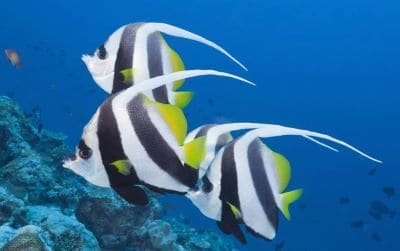Home › Sea Creatures › Marine › Vertebrates › Butterflyfish › Schooling Bannerfish
Interesting Facts about Schooling Bannerfish
[Phylum: Chordata] [Class: Actinopterygii] [Order: Perciformes] [Family: Chaetodontidae]
As its common name suggests, there is a schooling species of bannerfish that enjoys swimming together in large groups around shallow coral reefs.
This section contains fun facts and interesting information about the schooling bannerfish (Heniochus diphreutes), including where they live, what they eat, and how they reproduce.
Where Does the Schooling Bannerfish Live?
The tropical and temperate waters of the Indo-Pacific region provides ideal habitats for bannerfishes, especially:
- Polynesia (including Hawaii)
- East Africa to Asia (and The Red Sea)
- New Zealand (Kermadec Islands)
- South Japan
Shoals of schooling bannerfishes, up to one hundred, enjoy scavenging at the outer edges of rocky channels and reef slopes.
By and large, they spend most of the daytime in the five to thirty (30) metre depth range. But, they can survive in deep water too, (e.g. depths approaching 200 metres).
Schooling Bannerfish Characteristics
In fact, the schooling bannerfish (Heniochus diphreutes) is a close relative of the butterfly fish species in the family Chaetodontidae (meaning 'bristle-tooth').
Nonetheless, these marine ray-finned fish have several other nicknames, including coachman, pennant, and "false" moorish idol (especially by fishkeeping aquarists).
Here's the thing:
The schooling bannerfish has two distinguishing features. It has a deep "laterally" compressed body shape, with an elongated white filament that stretches out as the first ray of the unpaired dorsal fin.
It is also fair to say that few fish families (apart from the marine angelfish and butterflyfishes) have such a striking background colour.
The key composition is white, and they have two wide, black bands running vertically from top to bottom. But, the dorsal, caudal, and pectoral fins are all bright yellow.
Even though they have black coloured eyes, linked by a grey stripe, their head is white. They have a short nose, or snout, and a protractible mouth (i.e. extensible for feeding).
What Do Schooling Bannerfish Eat?
Even though schooling bannerfish are smaller than the longfin bannerfish (Heniochus acuminatus), adults can still grow to twenty one (21) centimetres long (8 inches).
 Being typical planktivores means their diet consists mostly of phytoplankton (microscopic marine algae).
Being typical planktivores means their diet consists mostly of phytoplankton (microscopic marine algae).
But, these peaceful feeders will also eat:
- Coral reef polyps (soft-bodied organisms)
- Invertebrate sea anemones
- Zooplankton (microscopic animals)
Despite schooling in large groups, they tend to be more timid during the darkness and will seek refuge in reef fissures and crevices.
Fun Fact: Several species of bannerfish will act as cleaner fish, especially the juveniles. Observations at the best Maldive dive sites also show them cleaning parasites off bumphead sunfish (Mola alexandrini).
Bannerfish Reproduction
Because butterfly fish are broadcast spawners, they release large numbers of buoyant, pelagic eggs into the open water near to the surface.
The eggs float with planktonic organisms in the currents until they hatch, usually within a day of fertilisation taking place.
Following that, the tiny fry enter the postlarval stage of Chaetodontidae and Scatophagidae (also called tholichthys stage). Simply put, large, bony armour plates extend from the head and cover the rest of the body in some of the postlarval fish species until they reach maturity.
Threats and Predators
According to information on the International Union for Conservation of Nature (IUCN) website, the current threat status for schooling bannerfish is stable and of 'Least Concern' (LC).
Fun Fact: Having a vivid and conspicuous colouration means they are popular fish for aquarium hobbyists to keep as pets.
Related Information and Help Guides
- Atoll Butterflyfish Fun Facts and Information with Pictures
- Butterflyfish Fun Facts and Information with Photographs
- Blenny Fish Facts and Species Information with Pictures
- Flashlight Fish Facts and Species Information with Pictures
- List of Marine Vertebrates Fish Examples for Beginners
- Wrasse Fish Facts and Species Information with Video
Note: The short video [39 seconds] presented by "DiveoneSG" contains footage showing how bannerfish school together in large groups in their natural habitat.